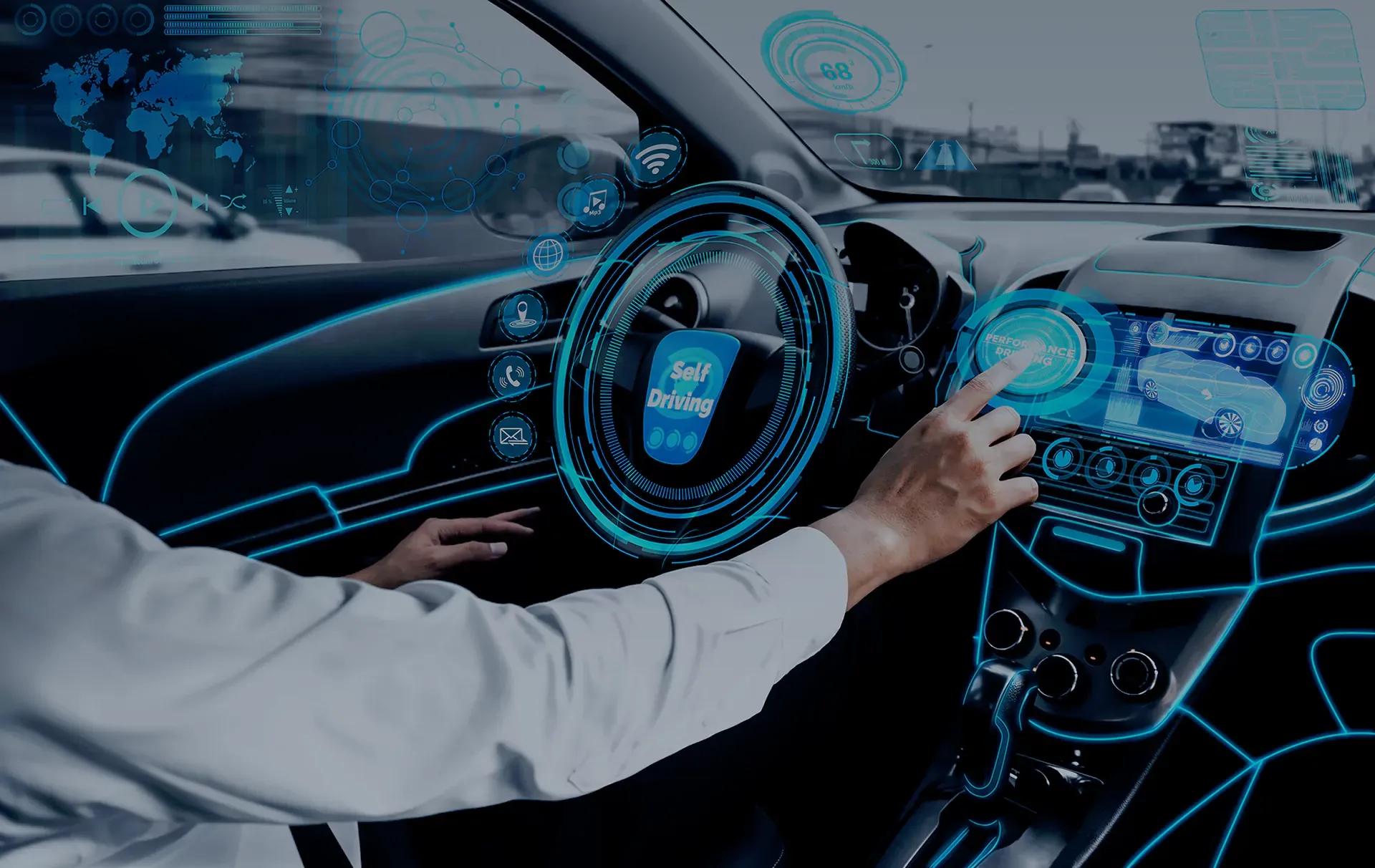
Inside the connected vehicles ecosystem
After talking to the fridge, the car does the shopping, takes us to work and then heads ten kilometres beyond the city, because there’s free parking there. In the meantime, it can earn its keep and act as a taxi. Why not?
We talked to Marek Wodzisławski, the head of MakoLab’s Connected Car department, about the future of the automotive sector.
For almost thirteen years now, Marek Wodzisławski has been involved in developing connected car software , working with the world’s most innovative brands to provide PoC and R&D solutions and production implementation. He was there at the birth of GENIVI, an alliance of the largest global automotive manufacturers which supports innovation in software for the sector and works to achieve standardisation across the industry. In his private life, cars are his thing and he has a particular love of the golden era of American motorisation.
Connected, Autonomous, Shared and Electric…they’re all trends that started dominating the discussion about the future of the automotive market some time ago. Could you tell us what point we’re at today? Also, in your opinion, how has the pandemic affected the development of technology in that area?
Time has shown that what underpins the existence of the entire, complex concept of CASE is the connected sphere. Without that, the other elements would be unproductive or their development would become ineffective. An example? An autonomous car can exist without being ‘connected’; trucks in Rotterdam’s Europoort have been moving without human participation for more than twenty-five years. But to all intents and purposes, without connectivity, the development of that technology is impossible. Moving on, car sharing wouldn’t have become popular if it weren’t for the easy-to-use apps on our smartphones that let us reserve a given car, locate it on the map, produce an invoice and pay the ‘rent’. It’s the same with the electric sphere, dealing with charging, monitoring and paying at the level of our smartphones.
With the start of the pandemic, the first step brought significant reductions to budgets for research and development related to autonomous vehicles. Car sharing also declined sharply. It’s natural for people not to turn to the collaborative economy at the moment. It doesn’t always seem safe, despite the fact the assurances given by numerous businesses about how they have taken every precautionary measure and about how their vehicles are disinfected. The electric sector has also been shaken. Oil prices fell drastically and there was scant interest in that type of car. The only sphere that’s remained at more or less a pre-coronavirus level is the connected car.
Why is the connected car sphere still so crucial? I sometimes like to compare the automotive industry and the smartphone sector. Let’s take Apple. Apart from the same devices, their business model is based on a closed system that has loads of functions which aren’t available from other manufacturers, as well as various services created solely for their phones. The automotive industry is slowly heading in the same direction. The physical product itself is one thing, but the entire ecosystem, the connectivity and, thanks to that, the exclusive services available to the customers of a given brand, is another. For instance, imagine a car doing the shopping for us.
Do you think that smartphones are going to be competing with cars and we’ll be happier to use the systems in our cars rather than the apps at our fingertips, in our pockets?
Of course not. We have to look at this subject from a different angle. Phones are relatively small. In a car, we have a massive, glass surface we could use. In addition, we’re usually very comfortable in them. So let’s imagine that, during a journey, we’ll be watching films, looking through photos or working and using a large screen located on the surface of the glass to do so.
How about combining work and driving a vehicle? Is that going to be possible in the none-too-distant future or is it an infinitely remote prospect? How do you envision it?
Who on earth said that we’ll be driving the vehicle or even sitting so that we’ll be facing the way we’re going? (He laughs) What some manufacturers are presenting as the vehicle of the future are concepts of travelling boxes, with no glass surfaces, built up on every side so as to turn them, literally, into travelling offices. On the other hand, I’m reminded of a conversation I had with a director from a sporty brand and how he reacted to my question about autonomous vehicles. He looked at me and replied with a question, “What are autonomous cars?” Some manufacturers won’t be heading in that direction at all. They’re focused on the driving experience.
But if autonomous cars do come onto the market, when will we have the chance to experience a ride in them? In five years? Ten?
The technology enabling autonomous journeys is under continuous development. Take Tesla. Their cars are already trying to go it alone on public roads. Mind you, there are plenty of people calling attention to the brand’s problems. Apparently, the autonomy of their vehicles doesn’t go above level three, so what we’re talking about are partially autonomous journeys. Full autonomy is level five. But that’s their business model. They’re developing their car ‘live’. ‘Traditional’ manufacturers are working on the technology with less publicity. I reckon that the big brands might well be further on the Tesla, but they’re waiting for the final polish that will allow them to show a finished version to the entire world. And I think that’s a matter of five years from now.
Returning to the connected car sphere, have you recently come across a solution that triggered the ‘wow’ effect?
Right now, you can do everything in a car. Really. I don’t think there’s any technology we’re familiar with from smartphones, televisions and computers that couldn’t be implemented in our cars. The main problem, and it’s something that I often mention and that manufacturers are starting to pay more and more attention to, is the UX. Sometimes, solutions that are works of genius in their underlying assumptions are unusable once they’ve been installed in a car. Take navigation. It’s been around for years, it’s been in use in the automotive industry for decades and yet it’s only quite recently that it’s proved possible to develop the appropriate ergonomic solutions that make using a car’s GPS system a comfortable experience. It wasn’t so long ago that a great many people preferred using their phones to the car’s system. Nowadays, though, that trend’s in retreat.
In what direction is a car’s communication with the outside world going to develop?
It all depends on the manufacturer. The quantity of data produced by a modern car is immense. The question is to how to use them so that they produce measurable business benefits. A while ago, a company from the insurance sector suggested installing special equipment which would monitor a driver’s style of driving. A scoring system was also created. The more economically and smoothly we drive, the lower the insurance fee we’ll be offered. Right now, that technology’s present in just about every car. Manufacturers’ offers already include insurance. Thanks to monitoring systems, third party and comprehensive insurance fees for top-end cars can be reduced by as much as fifty per cent or even more… thanks to the monitoring of our driving preferences and style. The condition will be using the car between seven in the morning and ten at night, for instance, and not turning off the traction control system. That kind of use might well be turning up more often before long. Manufacturers are working towards creating ecosystems featuring various services. New technologies make it easier to move into new business areas.
Like the car as part of the household, for instance.
Absolutely. That’s the real ‘mine’ of ideas for the making in the connected car sphere. Thanks to connectivity, it won’t be long before we’ll be able to make effective use of all the other elements of CASE. For instance, we’ll enter the meal we’d like to cook into our phone. The phone will communicate with our fridge and the fridge will check whether we have the ingredients we need. If we don’t, then it will send a message to our car. And, on its own, the car will go and do the shopping and then take it home for us. There’s much more. A car like that will take us to work and then, of its own accord, it’ll head ten kilometres beyond the city, because there’s free parking there. In the meantime, instead of just standing around doing nothing, it can earn its keep and act as a taxi. Why not? The prediction is that autonomous cars will be doing a lot more driving than their traditional counterparts.
But that’s all still a long way off, right?
Cars are really my thing and I’m typically old school about it, in other words, large engines and straightforward constructions, but I’m absolutely aware of what the future of the automotive industry is going to be. Studies have shown that people who’ve had the chance of travelling in those types of constructions aren’t afraid. On the contrary, they want to use that technology. A growing interest can be seen almost everywhere. That’s why there’ll be more and more investment in those kinds of solutions. There’s a constant push for their development.
One final question. In your opinion, which direction should contemporary businesses be taking?
Well, first and foremost, I’d answer a different question; where do they want to see themselves in five years’ time? In what segment? Boxy, autonomous cars? Or maybe they’ll be creating ecosystems of connected services based on cars? We’re capable of introducing a lot of values into the latter. We’re building tools and we have really extensive experience in developing UXs for the automotive industry, which is extremely important to the usability of given technologies.

Michał Hertel
Head of Communication




